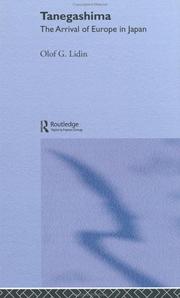| Listing 1 - 4 of 4 |
Sort by
|

ISBN: 0813118786 9780813118789 Year: 1995 Publisher: Lexington University Press of Kentucky
Abstract | Keywords | Export | Availability | Bookmark
 Loading...
Loading...Choose an application
- Reference Manager
- EndNote
- RefWorks (Direct export to RefWorks)
"Arms control remains a major international issue as the twentieth century closes, but it is hardly a new concern. The effort to limit military power has enjoyed recurring support since shortly after World War I, when the United States, Britain, and Japan sought naval arms control as a means to insure stability in the Far East, contain naval expenditure, and prevent another world cataclysm."--BOOK JACKET. "Richard Fanning examines the efforts of American, British, and Japanese leaders - political, military, and social - to reach agreement on naval limitation between 1922 and the mid-1930s, with focus on the years 1927-30, when political leaders, statesmen, naval officers, and various civilian pressure groups were especially active in considering naval limits. The civilian and even some military actors believed the Great War had been an aberration and that international stability would reign in the near future. But the coming of the Great Depression brought a dramatic drop in concern for disarmament."--BOOK JACKET. "This study, based on a wide variety of unpublished sources, compares the cultural underpinnings of the disarmament movement in the three countries, especially the effects of public opinion, through examination of the many peace groups that played an important role in the disarmament process. The decision to strive for arms control, he finds, usually resulted from peace group pressure and political expediency."--BOOK JACKET. "For anyone interested in naval history, this book illuminates the beginnings of the arms limitation effort and the growth of the peace movement."--BOOK JACKET.
Arms control --- History --- Navies --- Sea power --- Arms control - History. --- Navies - History. --- Sea-power - History. --- Sea-power --- Military power --- Navy --- Armed Forces --- Naval art and science --- Warships --- Security, International --- Arms race --- Disarmament --- Military readiness --- Arms --- Geschichte --- 1922-1933 --- J4888.10 --- J4884 --- J4880.80 --- Japan: Defense and military -- arms, weaponry --- Japan: Defense and military -- navy --- Japan: Defense and military -- history -- Gendai (1926- ), prewar Shōwa period, WW II, 20th century

ISBN: 0700716742 0700716750 8791114101 8791114128 Year: 2002 Volume: 90 Publisher: Copenhagen NIAS
Abstract | Keywords | Export | Availability | Bookmark
 Loading...
Loading...Choose an application
- Reference Manager
- EndNote
- RefWorks (Direct export to RefWorks)
Portuguese --- Weapons --- Portugais --- Armes --- History --- Sources --- Histoire --- Japan --- Japon --- Civilization --- Western influences. --- Religion --- Civilisation --- Influence occidentale --- J3352 --- J4813.73 --- J4810.50 --- J4888.10 --- J7018.80 --- J4880.50 --- Japan: History -- Chūsei -- Muromachi period -- Warring States period, Sengoku (1467-1558) --- Japan: International politics and law -- international relations, policy and security -- Europe -- Portugal --- Japan: International politics and law -- international relations, policy and security -- Muromachi, Sengoku and Azuchi-Momoyama periods (1392-1615) --- Japan: Defense and military -- arms, weaponry --- Japan: Natural sciences and technology -- Rangaku and yōgaku -- military science --- Japan: Defense and mlitary -- history -- Muromachi, Ashikaga, Sengoku and Azuchi-Momoyama periods (1392-1615) --- Japan: Science and technology -- Rangaku and yōgaku -- military science
Book
ISBN: 9783034316972 3034316976 Year: 2016 Publisher: Bern Peter Lang
Abstract | Keywords | Export | Availability | Bookmark
 Loading...
Loading...Choose an application
- Reference Manager
- EndNote
- RefWorks (Direct export to RefWorks)
Une présentation du processus d'institutionnalisation de l'arme biologique au Japon, systématisée et intégrée à la société d'après-guerre. L'auteur révèle le silence qui a recouvert les expériences atroces menées sur les prisonniers de guerre et sur les civils par la communauté scientifique japonaise et en particulier l'Unité 731, entre 1920 et 1945, et aborde la mémoire émergente de ces crimes. ©Electre 2016
Sino-Japanese War, 1937-1945 --- War crimes --- Guerre sino-japonaise, 1937-1945 --- Crimes de guerre --- Atrocities --- Atrocités --- Japan --- Japon --- History --- Histoire --- Biological weapons --- Chemical weapons --- J4880.70 --- J4880.80 --- J4880.90 --- J4888.10 --- Crime --- Weapons of mass destruction --- Bacteriological weapons --- Biological warfare agents --- Bioweapons --- Biosecurity --- Japan: Defense and military -- history -- Kindai (1850s- ), bakumatsu, Meiji, Taishō --- Japan: Defense and military -- history -- Gendai (1926- ), prewar Shōwa period, WW II, 20th century --- Japan: Defense and military -- history -- postwar Shōwa (1945- ), Heisei period (1989- ), contemporary --- Japan: Defense and military -- arms, weaponry
Book
ISBN: 9782081348134 2081348136 Year: 2015 Publisher: Paris: Flammarion,
Abstract | Keywords | Export | Availability | Bookmark
 Loading...
Loading...Choose an application
- Reference Manager
- EndNote
- RefWorks (Direct export to RefWorks)
Une synthèse sur l'histoire des kamikazes japonais, étayée par des témoignages de rescapés. Essentiellement recrutés parmi de jeunes étudiants, ils furent l'instrument spectaculaire de la propagande guerrière. L'ouvrage évoque leur place dans l'imaginaire collectif et les rapports difficiles du pays avec la mémoire. ©Electre 2015
Kamikaze airplanes --- World War, 1939-1945 --- Kamikazes (Avions) --- 2ème guerre mondiale --- Aerial operations, Japanese --- Opérations aériennes japonaises --- Suicide --- Campaigns --- Psychological aspects --- Japan. --- History --- 2ème guerre mondiale --- Opérations aériennes japonaises --- Killing oneself --- Self-killing --- Death --- Right to die --- Causes --- Kamikaze Tokubetsu Kōgekitai (Japan) --- Shimpū Tokubetsu Kōgekitai (Japan) --- Japanese Naval Special Attack Force --- 日本. --- History. --- World War (1939-1945) --- J3388 --- J4888.10 --- J4800.80 --- Japan: History -- Gendai, modern -- Shōwa period -- World War II -- Pacific war (1941-1945) --- Japan: Defense and military -- arms, weaponry --- Japan: International politics and law in general --- --Causes --- J4880.80 --- Japan: Defense and military -- history -- Gendai (1926- ), prewar Shōwa period, WW II, 20th century --- World War, 1939-1945 - Aerial operations, Japanese --- World War, 1939-1945 - Campaigns - Pacific Ocean --- Suicide - Japan - Psychological aspects --- tactique désespérée --- mourir pur vaincre --- endoctrinement --- terreur --- idéologie --- kamikazes --- Japon
| Listing 1 - 4 of 4 |
Sort by
|

 Search
Search Feedback
Feedback About UniCat
About UniCat  Help
Help News
News